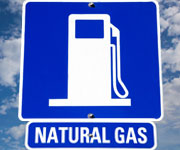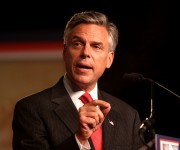Jon Huntsman.Photo: Gage SkidmoreCross-posted from Climate Progress.
Presidential candidate, former ambassador to China, and former Utah Gov. Jon Huntsman received attention for his willingness to accept scientists’ verdict that carbon dioxide and other pollutants generated by humans are responsible for climate change.
While 98 of 100 climate scientists agree that global warming is real, he is the only one out of nine Republican presidential candidates to say so. Nonetheless, his energy plan presented at a speech delivered on Tuesday in New Hampshire would increase global warming pollution. The other elements of the plan increase fossil fuel production and consumption, and are based on lack of understanding about energy use and policies.
Let’s take a closer look.
Just a few short years ago, then-Gov. Huntsman supported a cap-and-trade system to reduce the carbon dioxide pollution responsible for climate change. He even joined two other governors in ads for the Environmental Defense Fund that urge government action to reduce pollution. He noted that a program to reduce global warming would “bring new jobs and exports.” He concluded that “now it’s time for Congress to act by capping greenhouse gas pollution.”
During an Oct. 16, 2008, gubernatorial debate, Huntsman reiterated that it was essential to put a price on carbon dioxide pollution to protect public health and the climate.
Two months ago, Huntsman vigorously rejected Gov. Rick Perry’s (R-Texas) climate science denial, and warned that this approach could harm the Republican Party.
When we take a position that basically runs counter to what 98 of 100 climate scientists have said, what the National Academy of Sciences have said, about what is causing climate change and man’s contribution to it, I think we find ourselves on the wrong side of science and therefore in a losing position.
But all of Huntsman’s proposals outlined in his recent energy plan would exacerbate the problem, not address it. For example, he supports the construction of the Keystone XL pipeline that would carry tar-sands oil from Alberta to Texas to refine into gasoline and sell overseas. Tar-sands production [PDF] yields 14 to 25 percent more carbon dioxide pollution from “well to wheel” compared to conventional oil. Huntsman’s desire to develop these high carbon fuels while also recognizing the reality of climate change is like a doctor urging a cancer patient to increase his smoking.
In addition to support for policies that would make global warming worse, Huntsman is advocating policies that would ignore investments in new, clean technologies of the future. His case for these policies is based on so many false or misleading statistics, so let’s break them down:
Jon Huntsman’s claims about the energy world
Coal to liquid fuel is “an emerging technology.”
The facts: The Fischer-Tropsch process to convert coal to liquid fuel was perfected by the Nazis during World War II, and provided one-quarter of their gasoline. The dirty policy: Supports coal to liquid plants that produce significantly more carbon dioxide pollution.
“Today we import 60 percent” of our oil.
The facts: According to the Energy Information Administration (EIA), “the United States imported about 49 percent of the petroleum we consumed during 2010. The dirty policy: Allows more drilling, including in special vulnerable places such as the Florida Gulf Coast and protected areas in Alaska.
How can we stabilize our economy when its most fundamental building block is controlled in large part by despots and dictators half a world away?
The facts: Says the EIA, “49 percent of U.S. crude oil and petroleum products imports came from the Western Hemisphere during 2010. About 18 percent of our imports of crude oil and petroleum products come from the Persian Gulf.” The dirty policy: Increases risk of future blowouts by removing new safety requirements implemented after the BP Deepwater Horizon disaster last year.
We must remove the regulatory constraints on the production of domestic energy.
The facts: EIA found that “strong gains in the deepwater Gulf of Mexico and the Bakken formation brought decades of contraction in domestic oil production to a sudden halt, and even led to a rebound. U.S. crude oil output increased by an estimated 334,000 barrels per day between 2005 and 2010, further eroding the need for imported crude oil.” The American Petroleum Institute [PDF] estimates the “average active rotary drilling rigs in the U.S. as of Oct. 1, 2011: 1,978. (2010 average: 1,541).” This is a 28 percent increase. The dirty policy: Increases risk of future blowouts by removing new safety requirements implemented after the BP Deepwater Horizon disaster last year.
Coal “generates the majority of America’s power.”
The facts: EIA reports that coal was 21 percent of U.S. energy consumption in 2009. Coal generated 45 percent of U.S. electricity that year. The dirty policy: Expands the use of dirty coal without reductions in acid rain, smog, toxics, or carbon dioxide pollution from coal-fired power plants.
My administration will stand behind the Keystone pipeline, creating more than 100,000 American jobs while reducing our dependence on overseas imports.
The facts: TransCanada, the company that would build the Keystone pipeline, predicts that it would only “put 20,000 Americans to work to construct the project.” The U.S. Department of State estimates that “the construction workforce would consist of approximately 5,000 to 6,000 workers.” The dirty policy: Supports the Keystone XL pipeline even though it would produce significantly more carbon dioxide pollution than conventional oil production.
Hyperbolic fracking has been used on more than 1 million wells using a technology refined over 60 years.
The facts: There is no such thing as “hyperbolic fracking.” Hydraulic fracturing, or fracking, has been used to produce oil and shale gas. The dirty policy: Stalls rules to keep diesel fuel out of drinking water, and weakens the modest Clean Water Act protections for rivers and streams from water contaminated with radioactive materials and other pollutants. Eliminates the proposed reductions in smog and toxic air pollution from fracking operations.
As president, I will break down barriers to the continued, safe use of fracking.
The facts: There are no federal rules governing the disclosure of toxic fracking fluids, underground injection of contaminated water, or capture of fugitive methane — a major climate change pollutant. These are governed by state laws, which the president cannot overturn. The dirty policy: Stalls rules to keep diesel fuel out of drinking water, and weakens the modest Clean Water Act protections for rivers and streams from water contaminated with radioactive materials and other pollutants. Eliminates the proposed reductions in smog and toxic air pollution from fracking operations.
This summer, in fact, we will likely see blackouts as a result of the administration’s assault on coal.
The facts: Federal Energy Regulatory Commission Chair Jon Wellinghoff [PDF] recently testified before Congress that “regulations that the EPA recently finalized or is now considering will affect the operation of some electric generation units. With sufficient information and time, the electric industry can plan to meet both its reliability and environmental obligations.” Ralph Izzo, chair, president, and CEO of Public Service Enterprise Group, noted that “we believe our industry is capable of meeting these clean air rules while maintaining electric system reliability.” The dirty policy: Blocks reductions in mercury, arsenic, acid gases, and other airborne toxic chemicals from power plants. Without these safeguards, the American Lung Association reports that every year there would be 17,000 premature deaths; 11,000 heart attacks; 120,000 cases of childhood asthma symptoms; 12,000 hospitalizations and emergency room visits; and 11,000 cases of acute bronchitis among children.
Under my presidency, the United States will get out of the subsidy business. And if necessary, I will use my executive authority to act unilaterally.
The facts: Most federal energy subsidies are embedded in tax or energy laws. For example, there are $4 billion in annual tax breaks for big oil companies. It would require an act of Congress, signed by the president, to eliminate or modify them. The president cannot act unilaterally to eliminate them. The dirty policy: Leaves intact tax breaks for big oil and gas companies, even though the five largest oil companies made $101 billion in profits so far in 2011.
Huntsman distinguished himself from his competitors by accepting climate science. But the inconvenient truth is that his energy proposals vary little from those proposed by former Massachusetts Gov. Mitt Romney or Texas Gov. Rick Perry.
All three plans would expand the use of dirty fossil fuels while limiting investments in the deployment of renewable energy technologies and efficiency. Meanwhile, China, Germany, and other economic competitors race ahead to dominate the future $2 trillion global cleantech market. It’s time for all of these candidates to stop looking at policies of the past, and create a better vision for our energy future.



